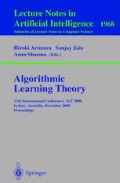Abstract
Explicit segmentation is the partitioning of data into homogeneous regions by specifying cut-points. W. D. Fisher (1958) gave an early example of explicit segmentation based on the minimisation of squared error. Fisher called this the grouping problem and came up with a polynomial time Dynamic Programming Algorithm (DPA). Oliver, Baxter and colleagues (1996, 1997, 1998) have applied the informationtheoretic Minimum Message Length (MML) principle to explicit segmentation. They have derived formulas for specifying cut-points imprecisely and have empirically shown their criterion to be superior to other segmentation methods (AIC, MDL and BIC). We use a simple MML criterion and Fisher’s DPA to perform numerical Bayesian (summing and) integration (using message lengths) over the cut-point location parameters. This gives an estimate of the number of segments, which we then use to estimate the cut-point positions and segment parameters by minimising the MML criterion. This is shown to have lower Kullback-Leibler distances on generated data.
Access this chapter
Tax calculation will be finalised at checkout
Purchases are for personal use only
Preview
Unable to display preview. Download preview PDF.
References
H. Akaike. Information theory and an extension of the maximum likelihood principle. In B. N. Petrov and F. Csaki, editors, Proceeding 2nd International Symposium on Information Theory, pages 267–281. Akademia Kiado, Budapest, 1973.
R. A. Baxter and J. J. Oliver. MDL and MML: Similarities and differences. Technical report TR 207, Dept. of Computer Science, Monash University, Clayton, Victoria 3168, Australia, 1994.
R. A. Baxter and J. J. Oliver. The kindest cut: minimum message length segmentation. In S. Arikawa and A. K. Sharma, editors, Proc. 7th Int. Workshop on Algorithmic Learning Theory, volume 1160 of LCNS, pages 83–90. Springer-Verlag Berlin, 1996.
J.H. Conway and N.J.A Sloane. Sphere Packings, Lattices and Groups. Springer-Verlag, London, 1988.
D. L. Dowe, R. A. Baxter, J. J. Oliver, and C. S. Wallace. Point estimation using the Kullback-Leibler loss function and MML. In Pacific-Asia Conference on Knowledge Discovery and Data Mining (PAKDD98), volume 1394 of LNAI, pages 87–95, 1998.
D. L. Dowe, J. J. Oliver, and C. S. Wallace. MML estimation of the parameters of the spherical Fisher distribution. In S. Arikawa and A. K. Sharma, editors, Proc. 7th Int. Workshop on Algorithmic Learning Theory, volume 1160 of LCNS, pages 213–227. Springer-Verlag Berlin, 1996.
T. Edgoose and L. Allison. MML markov classification of sequential data. Statistics and Computing, 9:269–278, 1999.
W. D. Fisher. On grouping for maximum homogeneity. Jrnl. Am. Stat. Soc., 53:789–798, 1958.
R. E. Kass and A. E. Raftery. Bayes factors. Journal of the American Statistical Association, 90(430):773–795, 1995.
J. J. Oliver, R. A. Baxter, and C. S. Wallace. Minimum message length segmentation. In X. Wu, R. Kotagiri, and K. Korb, editors, Research and Development in Knowledge Discovery and Data Mining (PAKDD-98), pages 83–90. Springer, 1998.
J. J. Oliver and C. S. Forbes. Bayesian approaches to segmenting a simple time series. Technical Report 97/336, Dept. Computer Science, Monash University, Australia 3168, December 1997.
J. J. Rissanen. Modeling by shortest data description. Automatica, 14:465–471, 1978.
J. J. Rissanen. A universal prior for integers and estimation by minimum description length. Annals of Statistics, 11(2):416–431, 1983.
J. J. Rissanen. Hypothesis selection and testing by the MDL principle. Computer Jrnl., 42(4):260–269, 1999.
G. Schwarz. Estimating the dimension of a model. The Annals of Statistics, 6:461–464, 1978.
S. Sclove. Time-series segmentation: A model and a method. Information Sciences, 29:7–25, 1983.
M. Viswanathan, C.S. Wallace, D.L. Dowe, and K. Korb. Finding cutpoints in noisy binary sequences-a revised empirical evaluation. In 12th Australian Joint Conference onArtificial Intelligence, 1999. A sequel has been submitted to Machine Learning Journal.
C. S. Wallace and D. M. Boulton. An information measure for classiifcation. Computer Jrnl., 11(2):185–194, August 1968.
C. S. Wallace and D. L. Dowe. Minimum message length and Kolmogorov complexity. Computer Jrnl., 42(4):270–283, 1999.
C. S. Wallace and D. L. Dowe. Rejoinder. Computer Jrnl., 42(4):345–357, 1999.
C. S. Wallace and D. L. Dowe. MML clustering of multi-state, Poisson, von Mises circular and Gaussian distributions. Statistics and Computing, 10:73–83, 2000.
C. S. Wallace and P. R. Freeman. Estimation and inference by compact encoding (with discussion). Journal of the Royal Statistical Society series B, 49:240–265, 1987.
Author information
Authors and Affiliations
Editor information
Editors and Affiliations
Rights and permissions
Copyright information
© 2000 Springer-Verlag Berlin Heidelberg
About this paper
Cite this paper
Fitzgibbon, L.J., Allison, L., Dowe, D.L. (2000). Minimum Message Length Grouping of Ordered Data. In: Arimura, H., Jain, S., Sharma, A. (eds) Algorithmic Learning Theory. ALT 2000. Lecture Notes in Computer Science(), vol 1968. Springer, Berlin, Heidelberg. https://doi.org/10.1007/3-540-40992-0_5
Download citation
DOI: https://doi.org/10.1007/3-540-40992-0_5
Published:
Publisher Name: Springer, Berlin, Heidelberg
Print ISBN: 978-3-540-41237-3
Online ISBN: 978-3-540-40992-2
eBook Packages: Springer Book Archive

